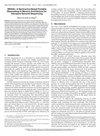WoperTM: Got Nacks? Use Them!
IF 1.4
3区 计算机科学
Q4 COMPUTER SCIENCE, HARDWARE & ARCHITECTURE
引用次数: 0
Abstract
The simplicity of requester-wins has made it the preferred choice for conflict resolution in commercial implementations of Hardware Transactional Memory (HTM), which typically have relied on conventional locking to escape from conflict-induced livelocks. Prior work advocates for combining requester-wins and requester-loses to ensure progress for higher-priority transactions, yet it fails to take full advantage of the available features, namely, protocol support for有零食吗?使用它们!
请求者获胜的简单性使其成为硬件事务性内存(Hardware Transactional Memory, HTM)的商业实现中解决冲突的首选,后者通常依赖于传统的锁定来避免冲突引发的活动。先前的工作主张将请求者获胜和请求者失败结合起来,以确保高优先级事务的进展,但它未能充分利用可用的特性,即对nack的协议支持。本文介绍了WoperTM,这是一种双策略、尽力而为的HTM设计,在一般情况下使用请求者丢失策略来解决冲突。我们的关键见解是,由于需要在HTM中支持优先级,因此通过允许常规事务从请求者丢失中获益,而不仅仅是那些涉及高优先级事务的事务,可以在几乎没有额外成本的情况下提高性能。使用gem5和STAMP的实验结果表明,WoperTM可以显著减少压缩工作,并将执行时间提高12%,而硬件开销可以忽略不计。
本文章由计算机程序翻译,如有差异,请以英文原文为准。
求助全文
约1分钟内获得全文
求助全文
来源期刊

IEEE Computer Architecture Letters
COMPUTER SCIENCE, HARDWARE & ARCHITECTURE-
CiteScore
4.60
自引率
4.30%
发文量
29
期刊介绍:
IEEE Computer Architecture Letters is a rigorously peer-reviewed forum for publishing early, high-impact results in the areas of uni- and multiprocessor computer systems, computer architecture, microarchitecture, workload characterization, performance evaluation and simulation techniques, and power-aware computing. Submissions are welcomed on any topic in computer architecture, especially but not limited to: microprocessor and multiprocessor systems, microarchitecture and ILP processors, workload characterization, performance evaluation and simulation techniques, compiler-hardware and operating system-hardware interactions, interconnect architectures, memory and cache systems, power and thermal issues at the architecture level, I/O architectures and techniques, independent validation of previously published results, analysis of unsuccessful techniques, domain-specific processor architectures (e.g., embedded, graphics, network, etc.), real-time and high-availability architectures, reconfigurable systems.
 求助内容:
求助内容: 应助结果提醒方式:
应助结果提醒方式:


